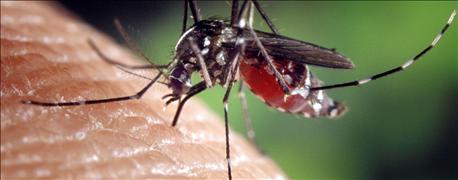July 17, 2016

Editor’s note: From Fredric Miller’s monthly natural resources column, Tree Talk.
Most people would agree: mosquitoes are probably the most dangerous animal on earth because of their role in disease transmission. In spite of our best pest management efforts, mosquitoes still debilitate and/or kill millions of people worldwide by transmitting malaria, filariasis, yellow fever, dengue, encephalitis, West Nile, and now Zika virus. As with ticks, we need to make sure we protect ourselves and others when outside.
Mosquito biology

PROTECT YOURSELF: Avoidance is the best way to protect yourself from mosquitoes this summer. If you are going to be in mosquito-infested areas, use a repellent. Regardless of the product, be careful with application and follow label directions. Photo: Public Domain Images
Mosquitoes belong to a group of insects known as flies, with all members having two wings. The word mosquito means little fly in Spanish. Female mosquitoes may live weeks or months, but males only about a week. During that time, the female takes a blood meal which stimulates ovulation (egg laying). Males do not bite nor take a blood meal. Depending on the species, eggs may be laid on vegetation near water, in still water, singly, or in rafts. The eggs hatch in just a few days. The larvae pupate in less than a week and three days later, adults emerge. Depending on temperature, a mosquito can complete its entire life cycle (egg to egg) in just 7-10 days with multiple generations occurring over the summer and early fall months.
In the Midwest, there are number of mosquito species that can be troublesome and spread disease. Our first group, the Culex mosquitoes, includes house mosquitoes, which reside in urban areas. They bite at dusk and after dark and rest in structures and on vegetation. Culex mosquitoes are known to transmit West Nile virus. Eggs are laid in rafts in objects that hold still water including tree holes, ditches, sewage and septic water, storm drains, and bird baths. They overwinter as adults in sewers, crawlspaces, and basements.
A second group, the Aedes mosquitoes, include inland floodwater, Asian tiger and tree hole mosquitoes. All prefer mammal blood, like ours. Like Culex mosquitoes, they lay eggs in flooded areas and water-holding containers. Inland floodwater mosquitoes are one of the first to appear in spring after heavy rainfalls and are strong fliers, traveling up to 10 miles in search of a blood meal. Biting starts in late afternoon and increases after dark. Fortunately, they are not major disease vectors and die with the first killing frost.
Arm yourself
So how do we protect ourselves, but still enjoy our summer? Avoidance is always the best policy. If you are going to be in mosquito infested areas, use a repellent. Regardless of the product, be careful with application, and follow label directions.
If you have ponds or larger bodies of water, larvae can be controlled with Bacillus thuringiensis israelensis or B. sphaericus bacteria applied to the water. These bacteria will not harm fish and other aquatics. Gold fish and/or mosquito fish can also be used.
Finally, try to reduce the source of mosquitoes: empty bird baths, wading pots, buckets and any water holding container on a regular basis.
In spite of what you may hear or read, the following approaches are not very effective or reliable: purple martins and bats, insect electrocuting devices, ultrasonic or electronic devices, and nutritional supplements or vitamins.
Just like ticks, mosquitoes are part of summer. By being informed and taking proper steps, we can protect ourselves and still have summer fun.
Miller is a horticulture professor at Joliet Junior College, and a senior research scientist in entomology at The Morton Arboretum in Lisle, Ill. Email your tree questions to him at [email protected].
You May Also Like




